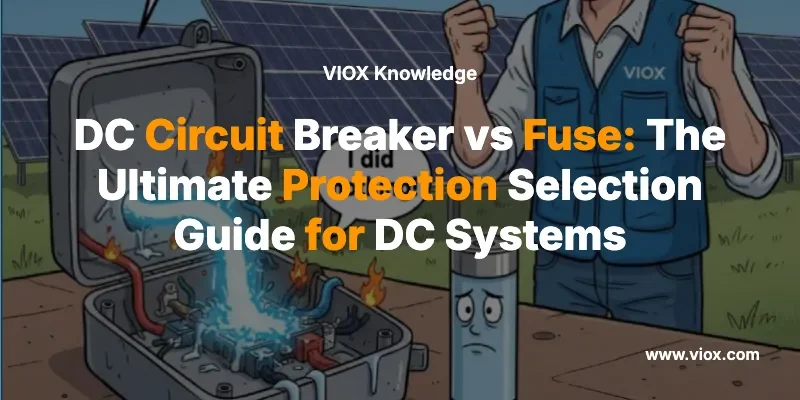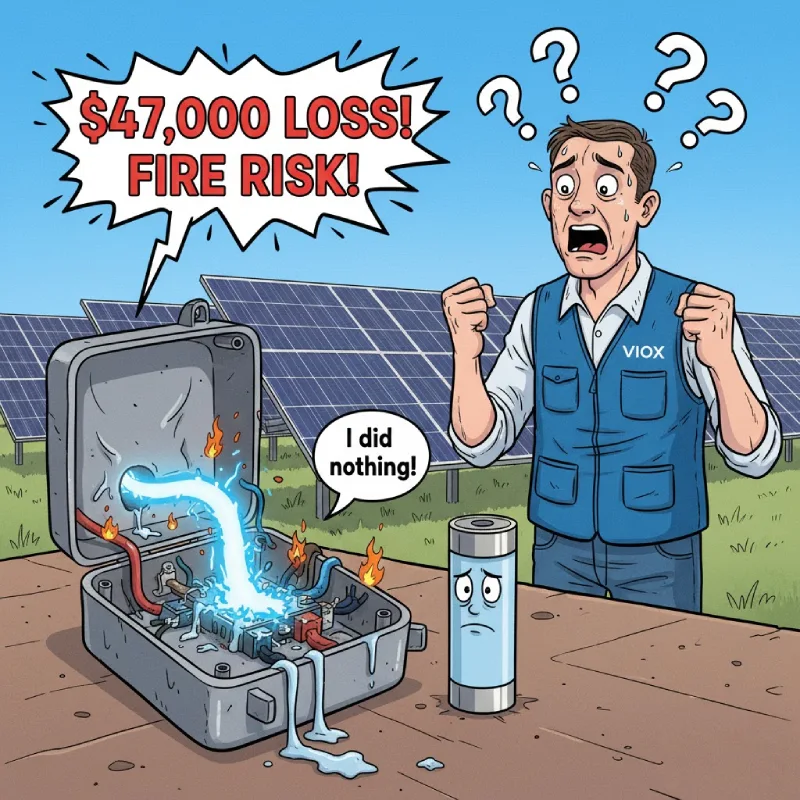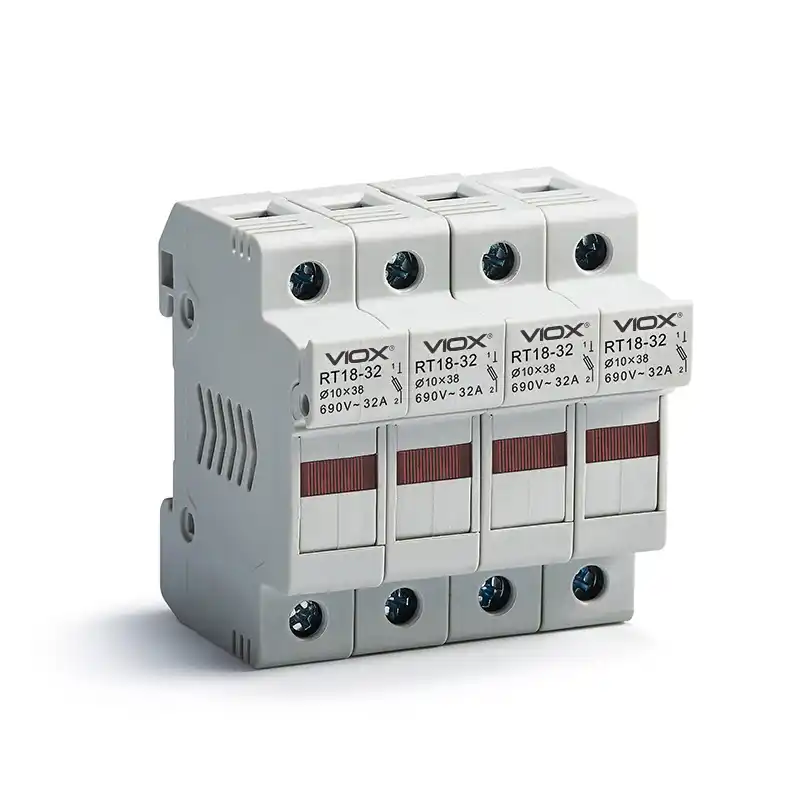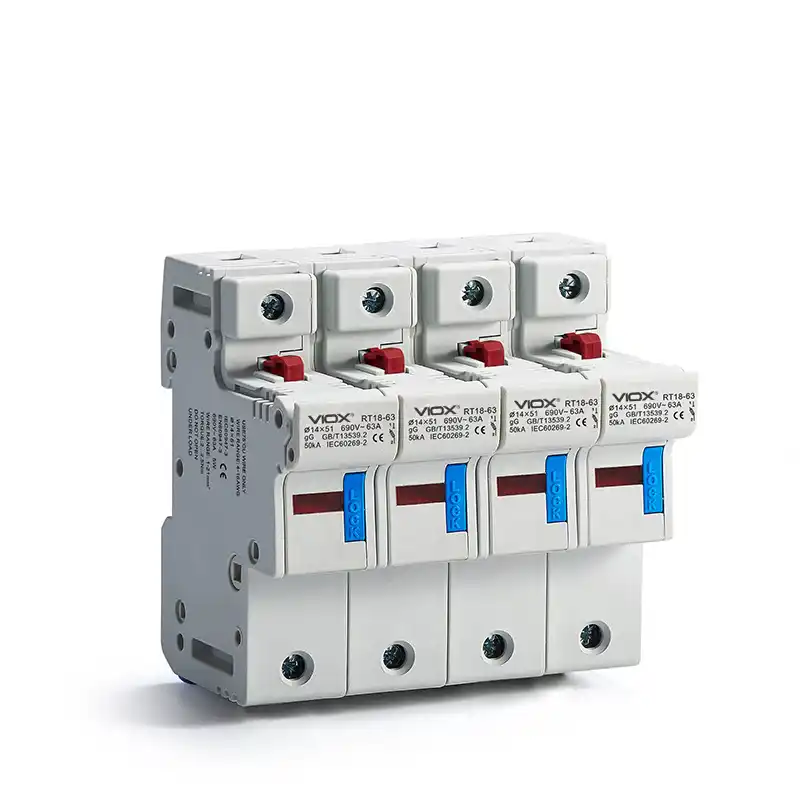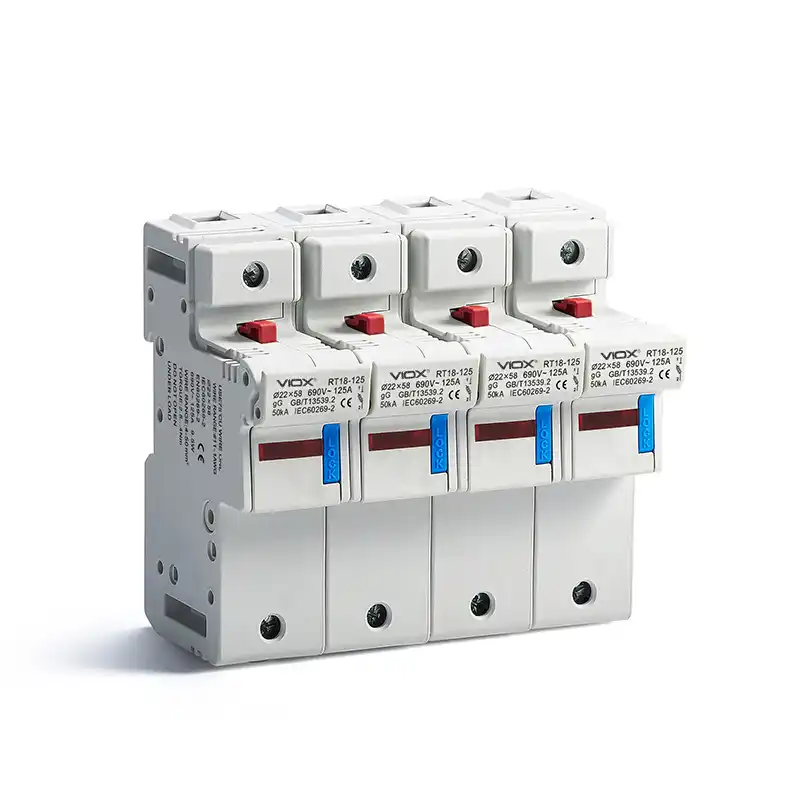The Silent Arc That Nearly Destroyed a $2 Million Solar Installation
The facility manager’s morning inspection seemed routine—until he noticed a faint glow inside Solar Combiner Box #3. What he discovered nearly cost his company everything: a sustained DC arc, burning silently at 3,000°F, had been consuming the connection terminals for hours. The plastic enclosure was melting. The wiring insulation was carbonized. And here’s what made his blood run cold: the overcurrent protection device had failed to interrupt the fault.
The investigation revealed the root cause: improper protection device selection for a DC application. The facility had used standard AC-rated fuses in a high-voltage DC solar array, unaware that DC arcs behave fundamentally differently than AC arcs.
The damage: $47,000 in equipment replacement, three days of lost production, and a near-miss fire that could have destroyed the entire facility.
Here’s the critical reality that many engineers and installers overlook: Direct current systems—whether solar arrays, battery banks, EV charging infrastructure, or industrial DC distribution—present unique protection challenges that demand specialized overcurrent devices. Unlike AC current that naturally crosses zero 120 times per second (helping extinguish arcs), DC current maintains constant voltage, creating persistent arcs that are exponentially harder to interrupt.
So here’s the engineering question every DC system designer must answer correctly: Should you use fuses or circuit breakers for DC overcurrent protection, and when is each technology the right choice?
The answer isn’t simply “one is better than the other.” Both technologies have distinct strengths and critical applications. Making the wrong choice—or worse, using AC-rated devices in DC systems—can result in protection failures, dangerous arc flash events, equipment damage, and catastrophic system failures.
Let’s solve this selection challenge with a comprehensive analysis that will help you choose the optimal protection device for your specific DC application.
Why DC Overcurrent Protection Is Fundamentally Different (And More Dangerous)
Before we compare fuses and circuit breakers, you need to understand why DC systems demand specialized protection in the first place.
The DC Arc Challenge: Why Zero-Crossing Matters
In alternating current (AC) systems, the voltage and current naturally cross through zero volts 120 times per second (in 60Hz systems). Each zero-crossing provides a natural opportunity for electrical arcs to extinguish. It’s like repeatedly removing the fuel from a fire—the arc struggles to sustain itself.
But DC systems have no zero-crossings. The voltage remains constant at its rated level, providing continuous energy to sustain arcs once they form. Think of it as a continuously fueled torch versus a flickering flame—the DC arc burns hotter, persists longer, and causes exponentially more damage before extinguishing.
The Dangerous Consequences of Inadequate DC Protection
When DC arcs form due to faults, loose connections, or equipment failures, the results can be catastrophic:
- Sustained arc temperatures exceeding 3,000°F (1,650°C) that melt copper conductors and ignite surrounding materials
- Arc plasma expansion that creates pressure waves and explosive force in enclosed equipment
- Equipment destruction as the arc literally vaporizes metal components
- Riscuri de incendiu from ignited insulation, enclosures, and nearby combustible materials
- Personnel safety risks including arc flash burns and explosive blast injuries
The engineering implication: Your DC overcurrent protection device must actively force current interruption—it cannot rely on natural zero-crossings like AC protection devices do.
This is precisely why both DC-rated fuses and DC circuit breakers incorporate specialized arc suppression technology. But they accomplish arc interruption through very different mechanisms, making each suited to different application scenarios.
The Solution: Matching Protection Technology to Application Requirements
The answer to “fuse or circuit breaker for DC protection” depends on six critical application factors:
- System voltage and available fault current
- Required response speed and coordination
- Operational downtime tolerance
- System complexity and maintenance capabilities
- Budget constraints (initial cost vs. lifecycle cost)
- Required features (selectivity, remote operation, monitoring)
Let’s break down each protection technology, its strengths, optimal applications, and how to make the right selection for your specific DC system.
DC Fuses: Fast, Simple, Cost-Effective Protection
How DC Fuses Work
DC fuses provide overcurrent protection through a fusible element designed to melt and vaporize when current exceeds the rated threshold. For DC applications, specialized fuses incorporate:
- Arc-quenching materials (often sand or ceramic granules) that absorb arc energy
- Controlled element design that creates multiple arc breaks as the fuse blows
- High-voltage insulation rated for DC voltage levels
- Fast-acting or time-delay characteristics matched to specific load types
The Compelling Advantages of DC Fuses
1. Ultra-Fast Response Times
DC fuses respond in milliseconds when fault currents exceed ratings. This speed is critical for protecting sensitive electronics, preventing equipment damage, and minimizing arc energy release. For high-speed faults like short circuits, fuses often operate faster than any circuit breaker can trip.
2. Zero Maintenance Requirements
Once installed, fuses require no periodic testing, calibration, or adjustment. They sit silently, providing reliable protection until called upon to operate—making them ideal for remote installations or systems with limited maintenance resources.
3. Extremely Low Initial Cost
Fuse holders and fuses cost a fraction of circuit breakers, making them economical for:
- Systems with many parallel protection points
- Budget-constrained installations
- Backup or secondary protection applications
- Small residential or portable systems
4. Excellent Arc Suppression
Quality DC-rated fuses (like Class T or Class J DC fuses) provide superior arc interruption through their sand-filled or ceramic construction that literally smothers the arc as the fuse element vaporizes.
5. Fail-Safe Operation
Fuses cannot be reset incorrectly or accidentally reclosed into faults—once blown, the circuit remains open until the fuse is physically replaced, forcing proper fault investigation.
Optimal DC Fuse Applications
Solar Photovoltaic String Protection:
– Individual string fuses in combiner boxes (typically 1-20A DC)
– Cost-effective protection for parallel strings
– Fast fault isolation prevents backfeed from healthy strings
– Replacement downtime acceptable during daylight maintenance hours
Small Device and Electronic Load Protection:
– Sensitive instrumentation circuits
– DC power supplies and converters
– Telecommunications equipment
– Compact systems where space is limited
Secondary or Backup Protection:
– Coordination with upstream circuit breakers
– Component-level protection within equipment
– Series redundancy for critical circuits
Budget-Conscious Installations:
– Residential solar systems
– Small off-grid applications
– Temporary or portable power systems
The Critical Limitations of Fuses
1. Single-Use Devices Requiring Replacement
Each fault operation requires fuse replacement, creating:
- Operational downtime while obtaining and installing replacement fuses
- Ongoing maintenance costs for spare fuse inventory
- Potential for incorrect fuse replacement (wrong rating or type)
- Labor costs for replacement, especially in remote locations
2. Limited Protection Characteristics
Standard fuses provide only one protection curve—you cannot adjust trip points or add features like ground fault detection, programmable delays, or remote monitoring.
3. Coordination Challenges in Complex Systems
In large DC distribution systems with multiple protection levels, achieving proper selective coordination with fuses alone can be difficult and may require oversized upstream devices.
Concluzie cheie: Choose DC fuses when you need the fastest possible protection at the lowest cost, and where occasional downtime for fuse replacement is acceptable. They excel in solar string protection, protecting sensitive electronics, and applications requiring simple, maintenance-free operation.
DC Circuit Breakers: Resettable, Advanced Protection
How DC Circuit Breakers Work
DC circuit breakers provide overcurrent protection through electromagnetic or electronic trip mechanisms combined with sophisticated arc interruption systems. Modern DC breakers feature:
- Arc chutes with magnetic blow-out coils that force arcs into extinguishing chambers
- Series-connected contacts that break the arc into multiple smaller arcs (easier to extinguish)
- Ceramic or composite arc runners that cool and stretch the arc
- Unități de declanșare electronice (in advanced models) offering programmable protection curves
- Resettable mechanisms allowing immediate restoration of power after fault clearing
The Compelling Advantages of DC Circuit Breakers
1. Resettability Reduces Downtime
After a fault is cleared, circuit breakers can be immediately reset—no waiting for replacement parts, no inventory management, no installation labor. For systems where downtime costs hundreds or thousands of dollars per hour, this advantage alone justifies the higher initial investment.
2. Enhanced Arc Extinguishing Technology
Modern DC circuit breakers incorporate advanced arc suppression mechanisms specifically engineered for DC applications:
- Magnetic blow-out coils that actively drive arcs into extinguishing chambers
- Series arc chutes that divide single arcs into multiple smaller arcs (lower voltage each)
- Ceramic barriers that rapidly cool arc plasma
- Controlled venting that safely exhausts arc gases
These technologies provide superior arc interruption compared to fuses, especially at higher voltage and current levels.
3. Integrated Protection Features
Advanced DC circuit breakers offer capabilities impossible with fuses:
- Setări reglabile ale cursei for both overload and short-circuit protection
- Ground fault detection (critical for ungrounded DC systems)
- Remote trip and monitoring via communication protocols
- Coordonare selectivă through adjustable time delays
- Arc flash reduction modes that provide ultra-fast clearing for safety
- Metering and diagnostics showing current, voltage, and power data
4. Comprehensive Protection Coordination
Circuit breakers allow precise coordination in complex systems:
- Upstream breakers can be set with time delays to allow downstream devices to clear faults first
- Adjustable instantaneous and time-delay bands prevent nuisance tripping
- Zone-selective interlocking communicates between breakers for optimal selectivity
5. Improved Safety and Maintainability
Unlike fuses (which require working on energized equipment for replacement), circuit breakers can be:
- Tested and exercised without removal
- Locked out for safe maintenance procedures
- Monitored remotely for condition assessment
- Reset without accessing potentially hazardous locations
Optimal DC Circuit Breaker Applications
Battery Bank and Energy Storage Systems:
– Large battery banks (lithium-ion, lead-acid, flow batteries)
– Energy storage systems (residential to utility-scale)
– UPS and backup power systems
– Electric vehicle charging infrastructure
Why breakers excel here: Battery fault currents can reach tens of thousands of amperes. Resettable protection prevents costly downtime, and advanced arc suppression safely interrupts these extreme currents.
Industrial DC Distribution:
– Manufacturing facility DC power distribution
– Data center DC power systems
– Process industry DC drives and controls
– Transportation systems (rail, marine, aviation DC buses)
Why breakers excel here: Complex systems require selective coordination, remote monitoring, and immediate restoration capability to minimize production losses.
Renewable Energy Main Disconnects:
– Solar array main disconnects (after combiner boxes)
– Wind turbine DC circuits
– Inverter input protection
– Large-scale solar farm collection systems
Why breakers excel here: These high-power, high-voltage applications demand robust arc interruption and the ability to quickly restore power after fault clearance during valuable production hours.
Critical Infrastructure and High-Reliability Systems:
– Emergency power systems
– Hospital and life-safety systems
– Communications infrastructure
– Military and aerospace applications
Why breakers excel here: When system uptime is paramount and safety is critical, resettable protection with advanced monitoring capabilities provides the highest reliability.
The Limitations of DC Circuit Breakers
1. Higher Initial Cost
Quality DC-rated circuit breakers cost significantly more than equivalent fuses—sometimes 5-20 times more depending on voltage and current ratings. For systems with many protection points, this cost difference can be substantial.
2. Maintenance Requirements
Unlike fuses, circuit breakers require:
- Periodic operation testing
- Inspecția și curățarea contactelor
- Mechanical lubrication (for some designs)
- Calibration verification
- Eventual replacement (typically 20-30 year service life)
3. Potential for Misuse
Resettable breakers can be improperly reset into uncleared faults, potentially causing equipment damage or safety hazards if proper fault investigation isn’t performed first.
Concluzie cheie: Choose DC circuit breakers when system complexity, downtime costs, high fault currents, or advanced protection features justify the higher investment. They excel in battery banks, industrial distribution, and applications where rapid fault clearance and immediate restoration are critical.
The Complete DC Protection Selection Guide: Making the Right Choice
Now that you understand both technologies, let’s create a practical decision framework.
Step 1: Assess Your Application Requirements
Ask yourself these critical questions:
System Characteristics:
- What is the DC system voltage? (Higher voltages favor breakers with superior arc suppression)
- What is the maximum available fault current? (Very high fault currents require robust breaker arc interruption)
- How many protection points does the system have? (Many points favor lower-cost fuses)
- Is the system simple (single source/load) or complex (multiple sources, loads, and protection zones)?
Operational Factors:
- What is the cost of system downtime per hour?
- How quickly must the system be restored after fault clearance?
- Is the installation location easily accessible for maintenance?
- Are spare parts readily available, or is the system remote/isolated?
Feature Requirements:
- Do you need adjustable protection settings?
- Is remote monitoring or control required?
- Do you need ground fault protection?
- Is selective coordination with other devices necessary?
Constrângeri bugetare:
- What is the available budget for initial installation?
- What are acceptable ongoing maintenance costs?
- How long is the expected system service life?
- What are replacement/upgrade costs over system lifetime?
Step 2: Apply the Selection Criteria
Use this decision matrix:
Choose DC FUSES when:
- ✓ Budget is the primary constraint and initial cost must be minimized
- ✓ Protection points are numerous (making breakers cost-prohibitive)
- ✓ Ultra-fast response (millisecond-level) is critical for sensitive loads
- ✓ Maintenance resources are limited or the system is remote
- ✓ Application is simple with straightforward protection requirements
- ✓ Occasional downtime for fuse replacement is acceptable
- ✓ Examples: Solar string protection, small device loads, secondary protection
Choose DC CIRCUIT BREAKERS when:
- ✓ System downtime costs justify higher initial investment
- ✓ Fault currents are very high (>10kA) requiring robust arc interruption
- ✓ Immediate restoration capability is critical for operations
- ✓ Advanced features are needed (adjustability, monitoring, remote control)
- ✓ System is complex requiring selective coordination
- ✓ Maintenance capabilities and resources are available
- ✓ Examples: Battery banks, industrial distribution, main disconnects, critical infrastructure
Step 3: Consider Hybrid Protection Strategies
Many optimal DC systems use ambele technologies strategically:
Typical Hybrid Architecture:
- Siguranțe at the component level (solar strings, individual loads)
- Întrerupătoare at main distribution points (battery disconnects, inverter inputs, feeders)
- Coordonare between devices ensures selective fault isolation
Why This Works:
- Minimizes overall system cost while providing robust main protection
- Fast fuse operation protects individual circuits and components
- Resettable breakers at main points prevent costly full-system downtime
- Natural coordination between fast-acting fuses and time-delayed breakers
Step 4: Verify DC Ratings and Certification
Critical Specification Verification:
| Specificații | Why It Matters | What to Check |
|---|---|---|
| DC Voltage Rating | Must exceed system voltage | Verify rating includes “DC” designation, not just AC voltage |
| Interrupting Rating | Must exceed available fault current | Check kA rating at your system voltage |
| DC Arc Suppression | Confirms proper arc extinguishing design | Look for arc chutes, blow-out coils, or sand-filled construction |
| Certification Marks | Proves testing to DC standards | UL 2579, IEC 60947-2 DC, or other DC-specific standards |
| Time-Current Curves | Ensures proper coordination | Verify curves are for DC operation, not AC |
Dangerous Mistake to Avoid: NEVER use AC-only rated devices in DC applications. AC ratings are meaningless for DC service—the device may fail to interrupt DC arcs, resulting in dangerous arc flash events and equipment destruction.
Application-Specific Recommendations: Real-World Scenarios
Sisteme solare fotovoltaice
String-Level Protection (1-20A per string):
– Recommendation: DC-rated fuses (Class T or RK5 type)
– De ce: Cost-effective for numerous parallel strings, ultra-fast protection prevents backfeed damage, replacement during daylight hours acceptable
– VIOX Product: String fuse holders with 600-1000VDC ratings
Combiner to Inverter (20-200A):
– Recommendation: DC circuit breakers with monitoring
– De ce: High fault currents require robust arc interruption, immediate reset capability valuable during production hours, remote monitoring for fault diagnostics
– VIOX Product: Molded case DC circuit breakers with electronic trip units
Sisteme de stocare a energiei în baterii
Cell-Level Protection:
– Recommendation: Fast-acting DC fuses
– De ce: Ultra-fast response critical for thermal runaway protection
– VIOX Product: High-speed semiconductor fuses
Battery String Disconnects (100-600A):
– Recommendation: DC circuit breakers with ground fault protection
– De ce: Extreme fault currents (>100kA possible), critical immediate restoration needs, ground fault detection essential for safety
– VIOX Product: Air circuit breakers with magnetic arc suppression and electronic trip units
Industrial DC Distribution
Load Feeders and Branch Circuits:
– Recommendation: Miniature DC circuit breakers (MCCBs)
– De ce: Resettability critical for minimizing production downtime, adjustable settings for load changes, remote monitoring integration
– VIOX Product: DIN-rail DC breakers with communication modules
Main Service Entrance:
– Recommendation: Power circuit breakers with selective coordination
– De ce: System protection requiring coordination with downstream devices, remote operation, advanced diagnostics
– VIOX Product: Draw-out DC power breakers with zone selective interlocking
DC Protection Technology Comparison: Quick Reference
| Caracteristică | DC Fuses | Întrerupătoare DC |
|---|---|---|
| Timp de răspuns | Ultra-fast (milliseconds) | Fast (milliseconds to cycles) |
| Reutilizare | No—requires replacement | Yes—immediately resettable |
| Suprimarea arcului | Good (sand/ceramic quenching) | Excellent (magnetic blow-out, arc chutes) |
| Întreținere | None required | Periodic testing/inspection recommended |
| Costul inițial | Low ($10-100 typical) | Higher ($100-5,000+ depending on size) |
| Costul ciclului de viață | Costuri continue de înlocuire | Minimal after initial investment |
| Ajustabilitate | Fixed characteristics | Adjustable trip points (electronic models) |
| Ground Fault Protection | Nu este disponibil | Available in advanced models |
| Monitorizare la distanță | Nu este disponibil | Available with communication modules |
| Coordonare selectivă | Limited—requires oversizing | Excellent—adjustable time delays |
| Fault Indication | Visual (blown fuse) | Visual + remote indication possible |
| Capacitatea de întrerupere | Good (10-200kA DC typical) | Excellent (up to 100kA+ DC) |
| Cele mai bune aplicații | Solar strings, small loads, backup protection | Battery banks, distribution, main disconnects |
| Typical Ratings | 1A to 600A, up to 1500VDC | 1A to 6000A, up to 1500VDC |
Greșeli frecvente de selecție de evitat
Mistake #1: Using AC Ratings for DC Applications
The Problem: AC voltage ratings, AC interrupting ratings, and AC time-current curves do NOT apply to DC service. An “AC 600V” device may only be suitable for 100VDC or less.
Soluția: Always verify explicit DC voltage ratings and DC interrupting ratings. Look for “VDC” specifications and DC-specific certifications.
Mistake #2: Undersizing for DC Voltage Considerations
The Problem: DC system voltage can vary significantly with load and charging state. A “48V battery system” might reach 58V during charging and drop to 42V under load.
Soluția: Size protection devices for maximum system voltage, including charging voltage, temperature compensation, and tolerance bands.
Mistake #3: Ignoring Available Fault Current
The Problem: Battery banks and solar arrays can deliver fault currents orders of magnitude higher than normal operating current. Inadequate interrupting ratings result in protection device failure during faults.
Soluția: Calculate maximum available fault current (considering all parallel sources) and select devices with interrupting ratings at least 25% higher than calculated values.
Mistake #4: Over-Relying on Cost Alone
The Problem: Choosing the cheapest option without considering downtime costs, maintenance expenses, or lifecycle performance.
Soluția: Calculate total cost of ownership over system lifetime, including installation, maintenance, replacement, and downtime costs.
Mistake #5: Neglecting Coordination
The Problem: In multi-level protection systems, improper coordination causes upstream devices to operate before downstream devices can clear faults, shutting down more of the system than necessary.
Soluția: Develop time-current coordination studies ensuring downstream devices clear faults before upstream devices operate (selective coordination).
Conclusion: Selecting the Right DC Protection for Your Application
The choice between DC fuses and DC circuit breakers isn’t about which technology is “better”—it’s about which technology best matches your specific application requirements, operational needs, and budget constraints.
Your DC Protection Selection Checklist:
- ✓ Identify system characteristics: Voltage, fault current, complexity, and number of protection points
- ✓ Assess operational priorities: Downtime tolerance, restoration speed, and maintenance capabilities
- ✓ Evaluate required features: Basic protection vs. advanced monitoring, control, and coordination
- ✓ Calculate total cost: Initial investment plus lifecycle maintenance and downtime costs
- ✓ Verify DC ratings: Explicit DC voltage ratings, DC interrupting capacity, and arc suppression design
- ✓ Consider hybrid strategies: Optimize cost and performance by using both technologies strategically
- ✓ Develop coordination plans: Ensure selective operation in multi-level protection architectures
Remember the critical takeaway: DC systems demand specialized protection because DC arcs don’t self-extinguish like AC arcs. Whether you choose fuses or circuit breakers, always verify genuine DC ratings and proper arc suppression capabilities.
Why VIOX ELECTRIC Leads in DC Protection Technology
VIOX ELECTRIC manufactures a comprehensive range of both DC fuses and DC circuit breakers specifically engineered for the unique challenges of DC overcurrent protection. Our DC protection products feature:
- True DC ratings with rigorous testing to UL 2579, IEC 60947-2 DC, and international standards
- Advanced arc suppression technology including magnetic blow-out coils and multi-break contact systems
- Wide voltage range supporting systems from 12VDC to 1500VDC
- Complete current ratings from 1A miniature breakers to 6000A power breakers
- Application expertise with engineering support for selection, coordination, and system design
- Quality manufacturing with CE, UL, and IEC certification for reliability and safety
Whether you’re protecting a residential solar installation, an industrial battery bank, or a mission-critical DC distribution system, VIOX ELECTRIC provides the engineered protection solutions your application demands.
Ready to specify the right DC protection for your system? Explore VIOX ELECTRIC’s complete DC fuse and circuit breaker product lines, download our DC Protection Selection Guide, or contact our technical team for application-specific recommendations and coordination studies.
Download our free DC System Protection White Paper for detailed technical information on DC fault calculations, arc flash hazards, protection coordination, and selection methodologies.
Întrebări Frecvente
Can I use an AC-rated circuit breaker or fuse in a DC application?
No—never use AC-only rated devices in DC applications. AC devices rely on the natural zero-crossing of AC current to help extinguish arcs. DC current has no zero-crossing, so AC devices may fail to interrupt DC arcs, resulting in dangerous sustained arcs, equipment destruction, and fire hazards. Always verify explicit DC voltage ratings and DC interrupting ratings before applying any protection device to DC circuits.
What’s the minimum DC interrupting rating I should specify?
Your DC protection device must have an interrupting rating at least 25% higher than the maximum available fault current in your system. For battery banks, this can exceed 100,000 amperes. For solar arrays, calculate fault current as the sum of all parallel sources. When in doubt, use conservative calculations or consult with VIOX ELECTRIC’s application engineers for fault current analysis.
Why are DC circuit breakers so much more expensive than AC breakers?
DC circuit breakers require significantly more sophisticated arc interruption technology than AC breakers. They must actively force current to zero (rather than waiting for natural zero-crossing) using magnetic blow-out coils, series arc chutes, and specialized contact materials. The engineering complexity, testing requirements, and lower production volumes for DC-specific designs all contribute to higher costs. However, for applications with high downtime costs, the resettability and advanced features quickly justify the investment.
How do I achieve selective coordination in DC systems?
Selective coordination ensures downstream protection devices clear faults before upstream devices operate. In DC systems, achieve this through: (1) Using fast-acting fuses downstream with time-delay breakers upstream, (2) Adjusting circuit breaker time-delay settings to create separation between protection levels, (3) Implementing zone-selective interlocking between intelligent breakers, or (4) Consulting coordination software or engineering analysis. VIOX ELECTRIC provides coordination study services to ensure optimal selectivity in complex DC systems.
Înrudite
MCB vs. Fuse: Why Your Motor Circuits Keep Failing (And the 3-Step Selection Guide)

